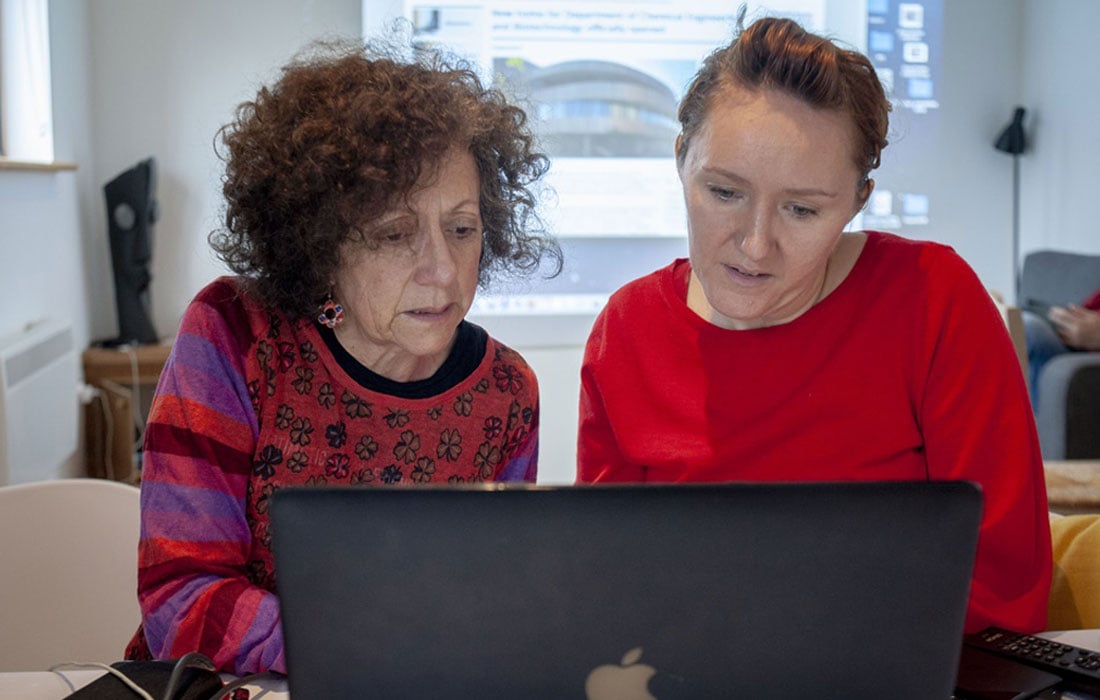
Bursary winner Diana Scarborough (left) working with Dr Ljiljana Fruk (right)
Ticking all the right boxes
Christine Harmar-Brown draws on her experience of submitting and assessing applications to offer some pointers on what works.
Invitations to apply for residencies, bursaries, mentoring, development support and any number of other offers can appear like beacons of light in these challenging times. When funding is getting harder to secure and commissions less forthcoming, programmes are shrinking and festivals are folding, what a lovely thing is the offer of something that helps you or your company, connects you with others and just, well, gets you noticed.
If the application requires you to outline what you hope to achieve or why this process is of value, give it some thought
In my experience, the reality is that no one is going to give you cash (or invite you in to the rehearsal room or provide you with a free space to experiment in), unless you demonstrate that you understand what’s on offer, what’s expected of you and that your project fits the brief.
Necessary focus
Having made numerous applications to various bodies (some successful, some not), I fully understand the feeling of dread that accompanies the start of the process. Unstable online forms, nit-picking detail and apparently repetitious questions can all be frustrating and bewildering.
However, I have also come to appreciate that being obliged to burrow deep into the reasons for a project, as well as my expectations, can actually help to focus on what, how and why I am doing it. It provides a deeper understanding of how the whole thing can work, and in the process make you so much sharper when communicating and enthusing others about your great idea.
A rigorous process
With the support of Arts Council England, B&R Productions recently launched a bursary offer called ‘Time to Stare’, a five-night residential creative retreat at our studio in rural East Sussex. It has been an interesting experience, being on the other side of the fence. We had applications for great projects, but some didn’t fit the brief, others didn’t provide all the information required, and then there were some that didn’t make the deadline. It was frustrating and bewildering.
It’s a two-way thing, I’ve discovered, and both sides have a responsibility, providing and agreeing to terms, in order that the experience is a positive one. Our selection panel spent four hours assessing a shortlist of six – a rigorous process that selected a rigorous application.
A strong submission
Here, then, are some suggestions on how to make a submission as strong as possible:
- Read the brief. Read it again. So many applications are not considered because the applicant has not fully read the brief.
- Do you fit the criteria? If the bursary or development residency is for new work, don’t apply to re-work an existing piece. However, in some instances re-working may be acceptable if you are presenting in a different context: outdoor to indoor, solo performance to full cast, but you need to check the criteria.
- Get in touch. If you are offered the opportunity to talk through the offer or ask questions, take it up. Much better to ask and get it right than assume and get it wrong.
- Are you sure this is right for you? Just because it’s on offer, that doesn’t mean it is right for you. Don’t apply if it isn’t.
- Provide what is asked for. If the application requires you to outline what you hope to achieve or why this process is of value, give it some thought.
- Do the facilities fit your requirements? There’s no point arriving with a truckload of materials or equipment if the space can’t accommodate them.
- Make sure you are available at the right time. If the offer is for two weeks in March, don’t assume you can attend in September when it suits you better.
- Be proactive about making the best use of the opportunity. Research the company or individual making the offer. What are the synergies? What can you learn?
- Most importantly, be open to the experience and get the most from it.
New directions
Ultimately, whatever the offer, be open to the opportunities presented. Whether you are embarking on a relationship with a mentor, undertaking a residency or embedding yourself in another organisation, the experience may well provide additional and unexpected avenues to explore.
Your work may be taken in a new direction, and what seemed impossible may become achievable with a new-found confidence and new synergies. Take advantage of the time and space you have been given and recognise the validation it affords you.
At the time of writing, Diana Scarborough, our first bursary recipient, is halfway through her residency. She’s using her time to develop her art science practice with various collaborators who have been coming and going. The atmosphere is fizzing with ideas, new connections have been made, former colleagues have re-connected and there’s an unexpected installation emerging.
Christine Harmar-Brown is Director of B&R Productions.
www.bandrproductions.co.uk
Applications for the next Time to Stare bursary are now open with a deadline of Friday 7 June.

Join the Discussion
You must be logged in to post a comment.